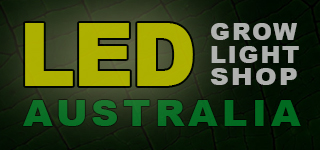Frequently Asked Questions
If you are using a single light over a plant or group of plants, the general rule of thumb is to hang your light a distance above the plants tops which is half of the widest point of the plants. So think of a 45 degree line going up from the sides. Example: Grow area is 1m*1m, hang the light 50cm above the canopy. Of course LED grow lights can get very close to your plants without ‘burning’, so depending on how ‘intense’ you are looking to grow, anything under this height can be acceptable, providing the light is covering the full width of the grow area – you may choose to add lights to cover more area with a consistent intensity.
LED grow lights produce much less heat than traditional HID grow lights. Most larger LED units have built in fans and heat sink units to eliminate heat from the source. This allows the light to be placed much closer to the plant canopy. There is still a small amount of heat produced, but you won’t have to go to such great lengths to keep your grow area cool!
Basically anything that has been grown with traditional grow lighting eg, HPS, MH, CFL can be grown with LEDs. So that means yes to vibrant, juicy fruits, vegetables, herbs, & flowers. Our lights cover those wanting to grow for miniature, hobby or commercial purposes. If you are unsure if our lights will work for your chosen plant feel free to contact us. 99.9% of the time, the answer is YES it’ll grow!
Most plants are generally seeking 2 types of spectrums; Red & Blue. The Blue being the key spectrums in the ‘growth’ or ‘vegetation’ stage, and the Red being key spectrums in the ‘flowering’ or ‘bloom’ period. Plants love to receive infinite colors of light as provided by the sun. When we grow with indoor lighting, our plants grow and bloom fastest under the ideal combination of red and blue spectrums. By adding more shades and colors we are improving the diversity of our color range which plants love. This can be associated with overall long term health. It is questionable whether more colors & spectrums will improve the speed of growth in short term grow applications.
Naturally this is all dependent on the size of your grow space and what you’re trying to achieve. As a basic guide, the full spectrum, dual phase & cobra light ranges are generally used for grow areas of 1 metre square or more (although often used in smaller areas). For the vegetation phase, you do not require as much light as the flowering/blooming phase. For small shorter plants, the tube or strip lighting may be for you. We encourage you to get in touch as we can give you much more indepth advice to help with your indoor grow.
If the light you purchased has IR in the range of colors, then your light is completely fine. IR is not immediately visible to the human eye, so don’t worry about it. If the light has IR, there is usually only a small percentage eg 1-2 pieces in that colour.
Certainly a hard question to answer accurately. Each type of plant has different requirements, each stage of growth has different requirements. With red (630-660nm) being the number 1, and blue (around 440-475nm) being the second most important, even with these two alone, your LED light is many times more efficient than the color given off from HID and fluro lighting. Manufacturers strive to deliver the ideal ratio in their units for the widest range of plants. Normally a mix of 2-12 colors/shades with red and blue the predominant colors. We also have several ‘growth boosters’ which focus on the blue & white spectrums for vegetation and early development in plants.
Yes. LED grow lights can be combined together, or used as supplementary light , either with other LED grow lights or with traditional ‘old school’ HID lights. Growers of larger setups will often use larger units for the main light source, and use smaller lights to reach the ‘hard to get’ places that don’t receive as much light from the primary source.
The life expectancy of the LED light units are 50,000-100,000 hours… Much higher than traditional grow lights (approx 10,000hrs)
The main reason that LEDs are so effective for growing plants, herbs, fruits & vegetables is because the light colour used is specific to the plants requirements for photosynthesis. Scientists have learned that the (predominantly) blue shades are key to vegetation and growth, while red shades are key for blooming & flowering. We’ve fine-tuned it down to a specific ‘nm’ (nanometres) so the light spectrums used with our lights are highly specialised for growing & flowering. This specific focus on the what the plant needs serves as a much more effective and efficient light source for all indoor plants.
Absolutely. You are dealing with Australian suppliers. All our products come with Australian standard fittings and the appropriate electrical certification standards.
